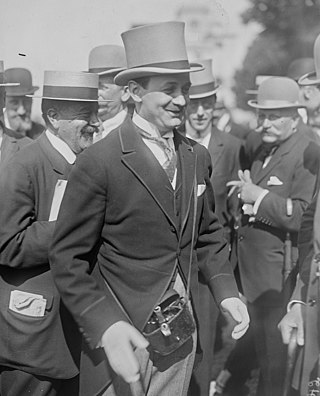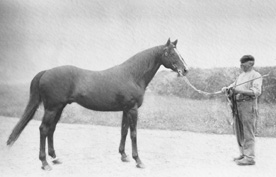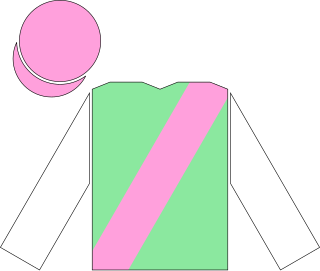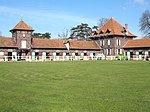
Marcel Boussac was a French entrepreneur best known for his ownership of the Maison Dior and one of the most successful thoroughbred race horse breeding farms in European history.
Haras du Quesnay, known as "Le Quesnay", is a thoroughbred horse breeding farm in France about four miles outside the city of Deauville on 3 km².
The Haras d'Ouilly is a renowned horse breeding farm in Pont-d'Ouilly, Calvados in the Normandy region of France established in the 19th century.

Hippodrome de Saint-Cloud is a grass race course for Thoroughbred flat horse racing opened in 1901 at 1 rue du Camp Canadien in Saint-Cloud near Paris, France. During World War 1, the race course site housed the No. 4 Canadian Stationary Hospital operated by the Canadian Army Medical Corp. On July 8, 1916 the No. 4 CSH was elevated to the No. 8 Canadian General Hospital and operated until decommissioned in 1919. The facilities were built by politician and Thoroughbred owner/breeder Edmond Blanc (1856–1920) in whose honor the Prix Edmond Blanc was established in 1921.

Flying Fox (1896–1911) was a champion British Thoroughbred racehorse who won the 1899 English Triple Crown and was the leading sire in France three times.

Count Evremond de Saint-Alary (1868–1941) was a leading owner and breeder of Thoroughbred racehorses in France. Heir of a well known family from the French West Indies, Saint-Alary became involved in horse racing as a young man in his twenties, and in the early 1890s acquired Haras de Saint Pair du Mont, a horse breeding farm at Le Cadran near Cambremer in Calvados, Normandy.
Haras de Saint Pair du Mont is a Thoroughbred horse breeding farm at Le Cadran near Cambremer in Calvados, Normandy. The business was founded circa the 1880s by renowned horseman, Leonce Delatre whose estate sold the property to Evremond de Saint-Alary in the early 1890s. On his death in 1941, Saint-Alary left the property to a lady friend, Mademoiselle Frémont-Tousch. Following her death, the farm was acquired by Jean Stern. In 1971, Stern's daughter, Madame Sanjust di Teulada, took over management of the property and the following March at Auteuil Racecourse disposed of a large portion of the bloodstock. In 1998 a Swedish gentleman named Goranson purchased the farm which still operates to this day under the management of Thierry de Chambord.

Gladiateur (1862–1876) was a French Thoroughbred racehorse who won the English Triple Crown in 1865. Gladiateur is called a legend by France Galop and "One of the best horses ever to grace the turf in any century" by the National Sporting Library of Middleburg, Virginia. Gladiateur was not very successful as a sire but his performance on the track remains one of the most impressive in Thoroughbred horse racing history.

Ksar (1918–1937) was a French Thoroughbred racehorse who had back-to-back wins in France's most prestigious horse race, the Prix de l'Arc de Triomphe.
Finasseur (1902–1909) was a French Thoroughbred racehorse who, at age three, won the two most prestigious races in France.

Pharos was a British bred thoroughbred racehorse and a leading sire in Great Britain and Ireland.

Cicero (1902–1923) was a British Thoroughbred racehorse and sire. He was the best English two-year-old of 1904, winning all five of his races. In 1905 Cicero became one of the shortest priced successful favourites in the history of the Derby, winning at 4/11 to remain undefeated. He won only once from his remaining three races before retiring to a modestly successful career at stud.

Dansili was a British Thoroughbred racehorse. He won five races, including the Prix du Muguet. After retiring from racing he became a successful stallion, with his progeny including Prix de l'Arc de Triomphe winner Rail Link and King George VI and Queen Elizabeth Stakes winner Harbinger. He also became Champion sire in France in 2006.
Val d'Or was a French Thoroughbred racehorse who was only defeated 16 times in his career. His wins included the Prix de Deux Ans, Grand Criterium, Poule d'Essai des Poulains and Eclipse Stakes. During his racing career he was owned by Edmond Blanc and trained by Robert Denman. After retiring from racing he became a sire in Argentina.
Chanteur was a French Thoroughbred racehorse and sire who was one of a group of French horses, including Caracalla, Marsyas, Arbar and Souverain, which dominated long-distance racing in Europe in the immediate post-war years. Unraced as a two-year-old, Chanteur won the Prix Hocquart in 1945 and the Prix Jean Prat in 1946. He reached his peak as a five-year-old when he won six races including the Prix des Sablons in France and the Coronation Cup in Britain. He was also placed in many important races including the Grand Prix de Paris, Prix de l'Arc de Triomphe, Prix Royal Oak, Prix du Cadran and Ascot Gold Cup. At the end of his racing career he was retired to stand as a breeding stallion in Britain, where he had considerable success as a sire of winners.
Polar Falcon was an American-bred, French-trained Thoroughbred racehorse and sire. Unraced as a two-year-old he showed promising form at three while appearing to be slightly below top class. He reached his peak as a four-year-old when he won the Prix Edmond Blanc in France before taking two major prizes in England. In May he defeated the leading filly In The Groove in the Lockinge Stakes over a mile and in September he beat a strong field to win the Ladbroke Sprint Cup over six furlongs. As a breeding stallion he is best known as the sire of Pivotal. He died in 2001 at the age of fourteen.

Sardanapale (1911–1934) was a French Thoroughbred racehorse and sire. He showed considerable talent as a juvenile, winning the Prix Yacowlef, Prix Morny and Prix de Seine-et-Oise. In the following year, he recovered from two defeats by La Farina to establish himself as the best racehorse in Europe with a string of victories which included the Prix Hocquart, Prix d'Hédouville, Prix du Jockey Club, Grand Prix de Paris, Prix de President de la Republique and Prix Eugène Adam before his racing career was ended by the outbreak of the First World War. He has been rated one of the best horses ever to be trained in France.
Sayani was a French Thoroughbred racehorse and sire. He was best known for his form as a three-year-old in 1946 when he won several important stakes races in England and France including the Prix Edmond Blanc, Prix Daphnis, Jersey Stakes and Prix Jacques le Marois. His best performance however, came when he recovered from a poor start to win the Cambridgeshire Handicap under a record weight. He was then retired to stud and became a successful breeding stallion first in France and later in Brazil.

Edmond Blanc was a horse breeder as well a French politician. He served as a member of the Chamber of Deputies from 1893 to 1894, and from 1898 to 1902, representing Hautes-Pyrénées. He also served as the mayor of La Celle Saint-Cloud. He was the owner of several stud farms in La Celle Saint-Cloud, Haras Villebon and Haras Hardy. He built the racecourse of Saint-Cloud inaugurated in 1901 along with a horse training center named La Fouilleuse. He won the Grand Prix de Paris seven times.
Clarissimus was a British Thoroughbred racehorse and sire. He was highly rated as a juvenile and showed promise by winning the Clearwell Stakes on the second of his two starts. He recorded his biggest when winning the 2000 Guineas on his debut as a three-year-old. Clarissimus went on to finish second in the Newmarket Stakes and a substitute St Leger before winning the Champion Stakes on his final appearance. After his retirement from racing he became a breeding stallion and had considerable influence as a sire of broodmares.











